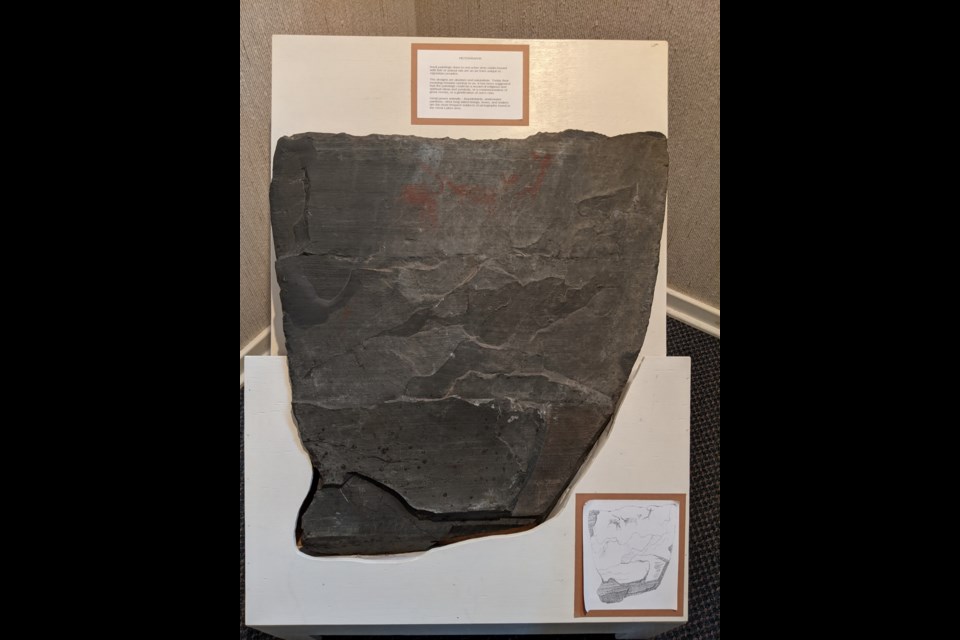A historically-significant artifact depicting three figures has returned home to Temagami First Nation after going missing decades ago.
In a collaborative effort between Temagami First Nation, Ontario Power Generation (OPG), Sault Ste. Marie Museum, and Woodland Heritage Northeast, the historical pictograph was repatriated to Bear Island just before Christmas 2020.
Temagami First Nation’s director of lands and resources Robin Koistinen said she has known about the missing pictograph for 25 years and has tried to locate it numerous times.
“We are very proud to have it back. Back on our land,” Koistinen said. “It really was a team effort.”
It is a 300-pound, metre-wide rock slab depicting three figures. The slab had fallen off the main rock face and was found lying face down at Matabichuan River by archaeologist Thor Conway in the '70s.
At the time, there were concerns that flooding and fluctuating water levels, caused by development on the river, could damage the rock and the paint.
According to Conway’s notes, the slab was taken to the regional archaeologist’s office in Sault Ste. Marie in 1977 for temporary study. The plans were then to return the slab to Temagami for public display.
“It is a preferred heritage policy only to remove rock art from its original setting under exceptional circumstances since paintings are so vitally tied by traditional beliefs to their local environment,” Conway wrote in 1980.
However, the rock went missing and its location was unknown until last year.
In the summer of 2020, OPG’s senior environment advisor Gillian MacLeod called Koistinen asking Temagami to participate in some archaeological assessment work at the Matabichuan River.
Koistinen agreed to send two field technicians Victoria Winsor and elder Mike Paul to the site, but there was a catch.
"When Gillian wanted to the work this summer, I said as part of the work and us assisting them, I wanted the pictograph located and returned to us," she said.
Working on the summer project were also Ryan Primrose, an archaeologist from the Woodland Heritage Northeast, and OPG’s Indigenous Relations Officer Sue Prince.
“Nobody knew where it was. And then, all of the sudden, somebody had a cue to call Sault Ste. Marie and, sure enough, there our pictograph was,” Koistinen said. “We’re very pleased to have it back within our nation.”
Just before Christmas, Winsor and a Temagami community member Mike Polson travelled to Sault Ste. Marie Museum to pick up the artifact. On the way back, their vehicle had to be barged across the lake to Bear Island to avoid damaging the artifact.
The pictograph is now displayed at the newly-built 16,000 square-foot Lakeview Gathering Place on Bear Island, where community members will be able to see the slab once the pandemic restrictions are lifted.
OPG helped with the efforts, including retrieving and protecting the pictograph while it was moved around, making sure that the display cabinet was suitable for its weight, and installing a plaque and descriptive display materials, according to Winsor.
“The process of finding this artifact was a fantastic collaborative effort,” Winsor said in a statement. “The museum’s curator has been enthusiastically assisting us, and the museum’s board have voted unanimously to repatriate the artifact … It is my hope that the return of an artifact represents a change in how archaeology and repatriation is conducted.”
This is the first repatriated artifact that is going to stay in the community. Previously, different artifacts were lent by museums to Temagami for educational purposes.
“But knowing how unique and special they are, we returned them because some of those facilities can take better care of some of those items because we don’t have the proper means to keep them in good condition,” Koistinen said.
“But it is our desire to repatriate our goods, our history, our implements, our artifacts.”
The pictograph isn’t something that can deteriorate like other artifacts, Koistinen said, and being in a display case in an air-controlled environment, as opposed to being exposed to natural elements, it should be “fine where it is," she said.
“We want to provide more context around it and label it more properly, so the history is with it there too, so people can understand it,” she said. “There’s a little more work to do to really, really make it display-worthy.”
The Sault Ste. Marie Museum’s executive director and curator William Hollingshead said the museum is happy to have the pictograph repatriated to Temagami First Nation.
"The minute I received the phone call about this artifact I knew exactly what they were talking about. Coincidentally, we were just looking at this piece and determining the history of it and its origin,” Hollingshead said. “It was great to find out where it truly belonged. To go (through) this process was humbling and a great experience. I can't wait to make a trip sometime to take a look at it in its new home.”
